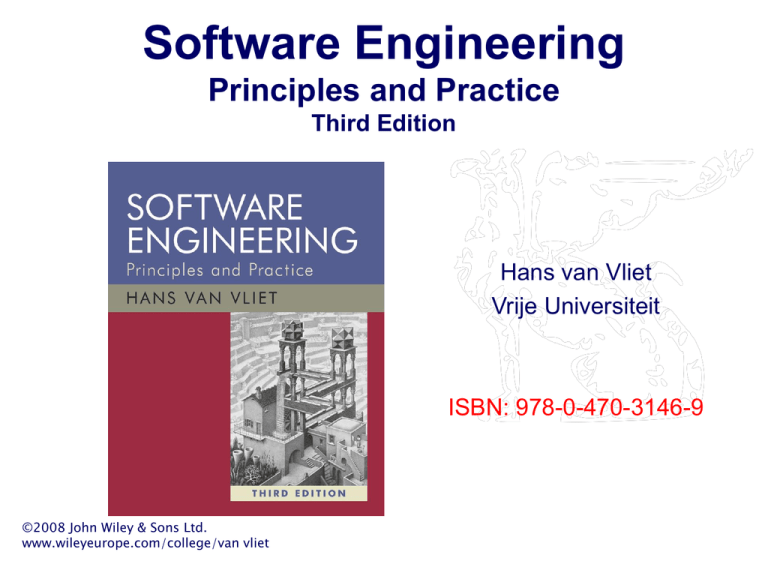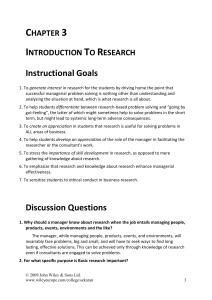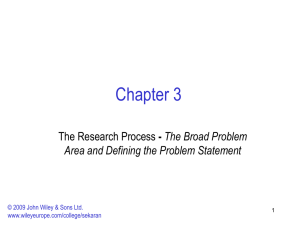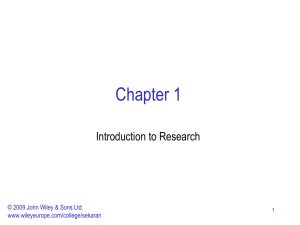Chapter 1: Introduction
advertisement

Software Engineering Principles and Practice Third Edition Hans van Vliet Vrije Universiteit ISBN: 978-0-470-3146-9 ©2008 John Wiley & Sons Ltd. www.wileyeurope.com/college/van vliet Chapter 1 Introduction ©2008 John Wiley & Sons Ltd. www.wileyeurope.com/college/van vliet ARIANE Flight 501 Disintegration after 39 sec Caused by large correction for attitude deviation Caused by wrong data being sent to On Board Computer Caused by software exception in Inertial Reference System after 36 sec. ©2008 John Wiley & Sons Ltd. www.wileyeurope.com/college/van vliet 3 The details Overflow in conversion of variable BH from 64-bit floating point to 16-bit signed integer Of 7 risky conversions, 4 were protected; BH was not Reasoning: physically limited, or large margin of safety In case of exception: report failure on databus and shut down ©2008 John Wiley & Sons Ltd. www.wileyeurope.com/college/van vliet 4 Possible explanations Inadequate testing Wrong type of reuse Wrong design philosophy ©2008 John Wiley & Sons Ltd. www.wileyeurope.com/college/van vliet 5 Inadequate testing? Specification does not contain Ariane 5 trajectory data as a functional requirement In tests, the SRI’s (components that measure altitude and movements of the launcher) were simulated by software modules ©2008 John Wiley & Sons Ltd. www.wileyeurope.com/college/van vliet 6 Improper reuse? If a component works perfectly well in one environment, it doesn’t necessarily do so in another Ariane 5 is much faster than Ariane 4, and horizontal velocity builds up more rapidly excessive values for parameter in question Wish for quick alignment after hold in shutdown this software runs for a while after lift-off. It doesn’t have any purpose for the Ariane 5, but was still kept ©2008 John Wiley & Sons Ltd. www.wileyeurope.com/college/van vliet 7 Wrong design philosophy? If something breaks down, such is caused by a random hardware failure Action: shut down that part There is no provision for design errors ©2008 John Wiley & Sons Ltd. www.wileyeurope.com/college/van vliet 8 Further information: IEEE Computer, jan. 1997, p. 129-130 http://www.cs.vu.nl/~hans/ariane5report.html ©2008 John Wiley & Sons Ltd. www.wileyeurope.com/college/van vliet 9 Software engineering The beginning 1968/69 NATO conferences: introduction of the term Software Engineering Idea: software development is not an art, or a bag of tricks Build software like we build bridges ©2008 John Wiley & Sons Ltd. www.wileyeurope.com/college/van vliet 10 Current status a lot has been achieved but … some of our bridges still collapse ©2008 John Wiley & Sons Ltd. www.wileyeurope.com/college/van vliet 11 Tacoma Narrows bridge ©2008 John Wiley & Sons Ltd. www.wileyeurope.com/college/van vliet 12 Same bridge, a while later ©2008 John Wiley & Sons Ltd. www.wileyeurope.com/college/van vliet 13 Further references Henry Petroski, Design Paradigms: Case Histories of Error and Judgement in Engineering A. Spector & D. Gifford, A Computer Science Perspective of Bridge Design, Comm. Of the ACM 29, 4 (1986) p 267-283 ©2008 John Wiley & Sons Ltd. www.wileyeurope.com/college/van vliet 14 Relative distribution of software/hardware costs 100 Percent of total cost Hardware Development 60 Software 20 1955 ©2008 John Wiley & Sons Ltd. www.wileyeurope.com/college/van vliet Maintenance 1970 Year 1985 15 Point to ponder #1 Why does software maintenance cost so much? ©2008 John Wiley & Sons Ltd. www.wileyeurope.com/college/van vliet 16 Definition (IEEE) Software Engineering is the application of a systematic, disciplined, quantifiable approach to the development, operation, and maintenance of software; that is, the application of engineering to software ©2008 John Wiley & Sons Ltd. www.wileyeurope.com/college/van vliet 17 Central themes SE is concerned with you’re doing it BIG programs together complexity is an software must issue effectively support users software evolves involves different development must disciplines be efficient SE is a balancing act ©2008 John Wiley & Sons Ltd. www.wileyeurope.com/college/van vliet 18 Building software ~ Building bridges? yes, and no software is logical, rather than physical progress is hard to see (speed progress) software is not continuous ©2008 John Wiley & Sons Ltd. www.wileyeurope.com/college/van vliet 19 Simple life cycle model problem requirements engineering reqs specification design design implementation system testing working system maintenance ©2008 John Wiley & Sons Ltd. www.wileyeurope.com/college/van vliet 20 Point to ponder #2 Is this a good model of how we go about? of how we should go about? ©2008 John Wiley & Sons Ltd. www.wileyeurope.com/college/van vliet 21 Requirements Engineering yields a description of the desired system: which functions possible extensions required documentation performance requirements includes a feasibility study resulting document: requirements specification ©2008 John Wiley & Sons Ltd. www.wileyeurope.com/college/van vliet 22 Design earliest design decisions captured in software architecture decomposition into parts/components; what are the functions of, and interfaces between, those components? emphasis on what rather than how resulting document: specification ©2008 John Wiley & Sons Ltd. www.wileyeurope.com/college/van vliet 23 Implementation focus on individual components goal: a working, flexible, robust, … piece of software not a bag of tricks present-day languages have a module and/or class concept ©2008 John Wiley & Sons Ltd. www.wileyeurope.com/college/van vliet 24 Testing does the software do what it is supposed to do? are we building the right system? (validation) are we building the system right? (verification) start testing activities in phase 1, on day 1 ©2008 John Wiley & Sons Ltd. www.wileyeurope.com/college/van vliet 25 Maintenance correcting errors found after the software has been delivered adapting the software to changing requirements, changing environments, ... ©2008 John Wiley & Sons Ltd. www.wileyeurope.com/college/van vliet 26 Global distribution of effort design 15% coding 20% requirements engineering 10% specification 10% testing 45% ©2008 John Wiley & Sons Ltd. www.wileyeurope.com/college/van vliet 27 Global distribution of effort rule of thumb: 40-20-40 distribution of effort trend: enlarge requirements specification/design slots; reduce test slot beware: maintenance alone consumes 50-75% of total effort ©2008 John Wiley & Sons Ltd. www.wileyeurope.com/college/van vliet 28 Kinds of maintenance activities corrective maintenance: correcting errors adaptive maintenance: adapting to changes in the environment (both hardware and software) perfective maintenance: adapting to changing user requirements ©2008 John Wiley & Sons Ltd. www.wileyeurope.com/college/van vliet 29 Distribution of maintenance activities corrective 21% perfective 50% adaptive 25% preventive 4% ©2008 John Wiley & Sons Ltd. www.wileyeurope.com/college/van vliet 30 Point to ponder #3 You are a tester, and the product you are testing does not yet meet the testing requirements agreed upon in writing. Your manager wants to ship the product now, continue testing so that the next release will meet the testing requirements. What do you do? Discuss the issue with your manager? Talk to the manager’s boss? Talk to the customer? ©2008 John Wiley & Sons Ltd. www.wileyeurope.com/college/van vliet 31 Hammurabi’s Code ©2008 John Wiley & Sons Ltd. www.wileyeurope.com/college/van vliet 32 Hammurabi’s Code (translation) 64: If a builder build a house for a man and do not make its construction firm, and the house which he has built collapse and cause the death of the owner of the house, that builder shall be put to death. 73: If it cause the death of a son of the owner of the house, they shall put to death a son of that builder. ©2008 John Wiley & Sons Ltd. www.wileyeurope.com/college/van vliet 33 Software Engineering Ethics - Principles Act consistently with the public interest Act in a manner that is in the best interest of the client and employer Ensure that products meet the highest professional standards possible Maintain integrity in professional judgment ©2008 John Wiley & Sons Ltd. www.wileyeurope.com/college/van vliet Managers shall promote an ethical approach Advance the integrity and reputation of the profession Be fair to and supportive of colleagues Participate in lifelong learning and promote an ethical approach 34 Quo Vadis? It takes at least 15-20 years for a technology to become mature; this also holds for computer science: UNIX, relational databases, structured programming, … Software engineering has made tremendous progression There is no silver bullet, though ©2008 John Wiley & Sons Ltd. www.wileyeurope.com/college/van vliet 35 Recent developments Rise of agile methods Shift from producing software to using software Success of Open Source Software Software development becomes more heterogeneous ©2008 John Wiley & Sons Ltd. www.wileyeurope.com/college/van vliet 36 The Agile Manifesto Individuals and interactions over processes and tools Working software over comprehensive documentation Customer collaboration over contract negotiation Responding to change over following a plan ©2008 John Wiley & Sons Ltd. www.wileyeurope.com/college/van vliet 37 Producing software Using software Builders build pieces, integrators integrate them Component-Based Development (CBSD) Software Product Lines (SPL) Commercial Off-The-Shelves (COTS) Service Orientation (SOA) ©2008 John Wiley & Sons Ltd. www.wileyeurope.com/college/van vliet 38 Open Source: crowdsourcing 1. 2. 3. 4. Go to LEGO site Use CAD tool to design your favorite castle Generate bill of materials Pieces are collected, packaged, and sent to you 5. Leave your model in LEGO’s gallery 6. Most downloaded designs are prepackaged No requirements engineers needed! Gives rise to new business model ©2008 John Wiley & Sons Ltd. www.wileyeurope.com/college/van vliet 39 Heterogeneity Old days: software development department had everything under control Nowadays: Teams scattered around the globe Components acquired from others Includes open source parts Services found on the Web ©2008 John Wiley & Sons Ltd. www.wileyeurope.com/college/van vliet 40 Point to ponder #4 Which of the following do you consider as Software Engineering Principles? Build with and for reuse Define software artifacts rigorously Establish a software process that provides flexibility Manage quality as formally as possible Minimize software components interaction Produce software in a stepwise fashion Change is inherent, so plan for it and manage it Tradeoffs are inherent, so make them explicit and document them Uncertainty is unavoidable, so identify and manage it ©2008 John Wiley & Sons Ltd. www.wileyeurope.com/college/van vliet 41 SUMMARY software engineering is a balancing act, where trade-offs are difficult solutions are not right or wrong; at most they are better or worse most of maintenance is (inevitable) evolution there are many life cycle models, and they are all models ©2008 John Wiley & Sons Ltd. www.wileyeurope.com/college/van vliet 42




